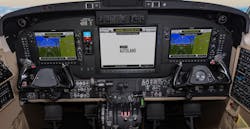Garmin announces its Autoland and Autothrottle avionics available for retrofit market in select Beechcraft King Airs
OLATHE, Kan., - Garmin in Olathe, Kansas announced imminent Federal Aviation Administration (FAA) certification to bring Garmin Autoland and Garmin Autothrottle avionics to the retrofit market, starting with select G1000 NXi-equipped King Air 200 series aircraft, and soon after, select King Air 300 series. The certification marks the first time Garmin Autoland and Autothrottle have been offered as a retrofit solution, as well as the first certification with G1000 NXi. Full Autothrottle integration with the G1000 NXi reduces crew workload in the cockpit by managing aircraft speed and power and provides engine protection against potential engine exceedances. In the event of an emergency where the crew can no longer perform their duties, Garmin Autoland can control and land the aircraft without human intervention.
Autothrottle is fully integrated with the G1000 NXi system and provides automatic control of the engine power levers from takeoff to landing. Autothrottle keeps power levers in the proper power setting, negating the threat of a possible throttle rollback. Power settings are based on manufacturer or user-configurable climb, cruise, and descent schedules, including ITT limits. Additionally, Garmin Autothrottle provides ITT and torque protection by reducing power when the system senses potential overtemperature or overtorque conditions.
Autothrottle will also activate automatically in the event of an aircraft overspeed or underspeed situation and takes into account flap and gear position, providing additional peace of mind for pilots operating the aircraft. If Autothrottle detects an engine failure, it automatically sets the power lever on the failed side to a fixed position and adjusts the operative throttle lever to maintain the selected airspeed reference.
Garmin Autoland
Autoland determines the most optimal airport and runway, considering factors such as weather, fuel on board, runway surface and length, terrain, obstacles and more. In the event of an emergency, passengers can activate Autoland by the press of a button, located in the back of the center pedestal for easy access. Autoland will activate automatically if the system determines it's necessary.
Once activated, the system calculates a flight path to the most suitable airport, initiates an approach to the runway and automatically lands the aircraft. The system takes into consideration a breadth of information and criteria and will automatically communicate with air traffic control (ATC) throughout the entire event, advising controllers and pilots operating near the aircraft of its location and intentions.
Throughout an Autoland activation, the system provides simple visual and verbal communications in plain language, so passengers have the information and know what to expect. The flight displays show the aircraft's location on a map alongside information such as the destination airport, estimated time enroute, distance to the destination airport and fuel remaining. Airspeed, altitude and aircraft heading are labeled in an easy-to-understand format and passengers also have the option to communicate with ATC by following instructions on the multi-function display.
At any time, a pilot can easily deactivate Autoland with a single press of the "AP" autopilot key on the autopilot mode controller, or the autopilot disconnect button on the yokes. The flight display shows a message that confirms Autoland has been deactivated and in the event of an accidental deactivation, the system shows passengers how to reactivate Autoland if needed.
During an Autoland activation, the Garmin Autothrottle system is used to automatically manage aircraft speed and engine power so the aircraft can climb, descend or maintain altitude as needed. If temperatures are conducive to ice accumulation, Autoland activates anti-ice and deice systems for the engines and control surfaces. On approach to landing, the system initiates a controlled descent to the airport. If the aircraft needs additional time to descend or slow down during the approach, the Autoland system initiates a standard holding procedure. Once Autoland configures the landing gear and flaps, the aircraft begins its descent to the runway and lands. On the runway, automatic braking is applied while tracking the runway centerline to bring the aircraft to a complete stop. Engine shutdown is also automated so occupants can safely exit the aircraft.
